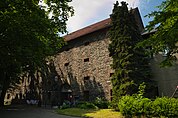Siemianowice Śląskie
Siemianowice Śląskie | ||
|---|---|---|
 City Hall | ||
|
Car plates SI | | |
| Primary airport | Katowice Airport | |
| Website | http://www.siemianowice.pl | |
Siemianowice Śląskie also known as Siemianowice (Polish pronunciation:
It is situated in the
Etymology
There are three hypothetical explanations for the origins of the name Siemianowice: either it comes from seven huts which were called Siedminowice/Siedmionowice in Old Polish; from the old legend about Siemion (Siemian), Michał and Maciej, or Siemion, Michał and Jakub; or it comes from ziemia nawa which means earth taken away from water.
Administrative division
- Centrum – 11,98 km2
- Michałkowice – 5,46 km2
- Bańgów – 2,96 km2
- Przełajka – 2,7 km2
- Bytków – 2,3 km2
History

Siemianowice dates back to
In 1924, Siemianowice and Huta Laury communes were merged. The new city was named Siemianowice Śląskie and gained town privileges in 1932.
On 1 September 1939, the first day of the German
In 1951, Michałkowice, Bytków, Bańgów and Przełajka were included within the city limits of Siemianowice as new districts.
Industry
- Adient (
 United States, Car Parts Manufacturing)
United States, Car Parts Manufacturing) - Arcelor Mittal (, Steel Manufacturing)
 Luxembourg
Luxembourg - Fastening Elements Factory (
 Poland, Fastening Hardware Manufacturing)
Poland, Fastening Hardware Manufacturing) - Rosomak S.A. (
 Poland, Defence Systems)
Poland, Defence Systems) - Fabud (
 Poland, Building Company)
Poland, Building Company) - Huhtamäki (
 Finland, Specialty Packaging Products)
Finland, Specialty Packaging Products)
Notable architectural structures
- Bytków TV Tower
- Park Tradycji ("Tradition Park") at the old coal mine
- Municipal Museum in an old granary
- Municipal Bath
- Palace of the Mieroszewskis and Donnersmarcks
- Zameczek Palace (Rheinbaben Palace)
- Town hall
- Saint Michael Archangel church
- Holy Cross church
- Municipal Public Library
- Siemianowice Culture Center
- Brewery
Parks and squares
- Park Miejski ("Municipal Park")
- Park Górnik ("Miner Park")
- Park Pszczelnik
- Planty Michałkowickie
- Skwer Laury ("Laura Square")
- Plac Wolności ("Freedom Square")
Sports
The local football club is MKS Siemianowiczanka.[9] It competes in the lower leagues.
Notable people
- Laurahütte
- Ernst Steinitz (1871–1928, German mathematician
- Wojciech Korfanty (1873–1939), Polish politician
- Otto Josef Schlein (1895–1944), German physician
- Michael Jary (1906–1988), German composer
- Heinz A. Lowenstam (1912–1993) German-born, Jewish-American paleoecologist
- Antoni Halor (1937–2011), Polish film director, artist, writer
- Witold Ziaja (born 1940), Polish field hockey player
- Zygmunt Maszczyk (born 1945), Polish footballer
- Józef Skrzek (born 1948), musician, leader of SBB band
- Barbara Blida (1949–2007), Polish politician
- Bronisław Korfanty (born 1952), Polish senator
- Apostolis Anthimos (born 1954), musician
- Henryk Średnicki (1955–2016), Olympic boxer
- Krzysztof Globisz (born 1957), Polish actor
- Daniel Podrzycki (1963–2005), Polish politician
- Jacek Fröhlich (born 1965), Automotive Designer, BMW exterior design chief
- Kryspin Hermański (born 1984), Polish dancer
- Karol Gwóźdź (born 1987), Silesian artist, writer and musician
- Kajetan Duszyński (born 1995), Polish sprinter, Olympic medallist
Twin towns – sister cities
Siemianowice Śląskie is twinned with:[10]
 Câmpia Turzii, Romania
Câmpia Turzii, Romania Jablunkov, Czech Republic
Jablunkov, Czech Republic- Köthen, Germany
 Mohács, Hungary
Mohács, Hungary Wattrelos, France
Wattrelos, France
References
- ^ a b "Local Data Bank". Statistics Poland. Retrieved 16 August 2022. Data for territorial unit 2474000.
- European Spatial Planning Observation Network (ESPON) "Project 1.4.3". Archived from the originalon 2009-07-28. Retrieved 2009-03-28.
- ^ a b c d "Wojna rozpoczęła się w Michałkowicach…". siemianowice.slask.pl (in Polish). 30 August 2010. Retrieved 15 May 2021.
- ^ Wardzyńska, Maria (2009). Był rok 1939. Operacja niemieckiej policji bezpieczeństwa w Polsce. Intelligenzaktion (in Polish). Warszawa: IPN. p. 135.
- ISSN 1641-9561.
- ^ "Polenlager Laurahütte". Bundesarchiv.de (in German). Retrieved 15 May 2021.
- ^ "Zwangsarbeitslager für Juden Laurahütte". Bundesarchiv.de (in German). Retrieved 15 May 2021.
- ^ a b "Laurahütte". Memorial and Museum Auschwitz-Birkenau. Retrieved 15 May 2021.
- ^ "MKS Siemianowiczanka" (in Polish). Retrieved 15 May 2021.
- ^ "Miasta partnerskie". siemianowice.pl (in Polish). Siemianowice Śląskie. Retrieved 2020-03-11.
- This article may be expanded with text translated from the corresponding article in the Polish Wikipedia (December 2008)
External links
- Jewish Community in Siemianowice Śląskie on Virtual Shtetl
- Sights
- Old photos







